The Grapes Behind Italian White Wines
For those of us who don’t live there, Italy often seems to be a dream world. It’s one of the few countries that
look even better in real life than it does in print or on the silver screen, and its food has justifiably influenced
the entire spectrum of gastronomy, from humble pizza joints through the upper echelon of cuisine.
No surprise, then, that Italy would also be a wine geek’s paradise. A staggeringly diverse range of wine styles are crafted across
the country’s varied soils, topography, and climates. Incredibly, this relatively small country is the birthplace of over 25 percent
of the world’s fine wine grape varieties.
Getting a handle on all of those Italian-born grape varieties is beyond the scope of this humble article
(a recent book about Italy’s native wine grapes clocks in at over six hundred pages), but taking a trip across Italy by
exploring wines made from its indigenous grapes is just too fun not to do for any self-respecting wine lover. Has there
ever been a better homework assignment than that?
Here are five of the most interesting white wine grapes that were born in Italy, along with the histories and tasting notes that you’ll need
to sound like a serious wine geek when you pull the cork on one of these wines at your next party.
Cortese
At the risk of confusing you right out of the gate, the Cortese grape itself, and the vineyards of its home turf in Gavi (in Italy’s
northwestern Piedmont region) mirror the complexity of Italy’s native grape portfolio. Seventy-five different Cortese biotypes have been
described, and there are many different soil types within the Gavi growing region. Once the darling of the Italian white wine world, Cortese
got too popular in the 1980s, when it was over-yielded and used to make pretty boring wines. Thankfully, Cortese and Gavi are now seeing a
resurgence that befits the grape’s heritage; it’s been a part of the Piedmont region since at least the seventeenth century, appearing in a
cellar inventory dating to 1614.
Romantically, Cortese’s region of Gavi was said to have been named after Princess Gavia, who eloped with her true love, later to be given
the region as a wedding gift. In reality, the name comes from the Latin term for cavern, which is far less romantic. The best wines made from
Cortese (look for the designations Gavi di Gavi, and Gavi di Tassarolo) reflect a bit more of the Gavi romance. They often have refreshing
acidity, with flavors of apples, honeydew melons, and peaches. The best can also offer complex aromas of wet stones, grass, and even white flowers.
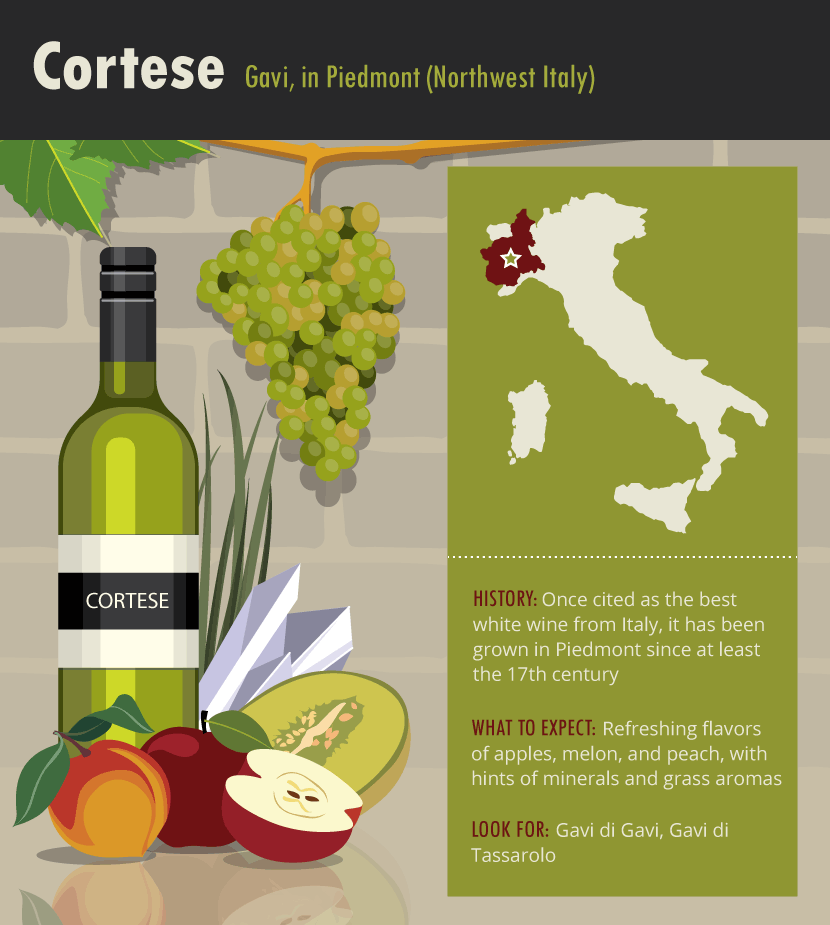
Verdicchio
Named after the grape’s greenish hue, Verdicchio thrives in the central region of Marche. It might have been brought there from the Veneto,
either by the prolifically wandering Venetian traders, or during repopulation of Marche in the aftermath of The Black Death. Either way, Verdicchio
has been in Marche for a long time, dating back to the fourteenth century.
While it might not be a household name in the U.S., Verdicchio is often cited as the white wine grape that best displays Italy’s diversity and quality potential.
While some sub-standard Verdicchio is made, at its best the wine is stunning, delicious, long-lived, and able to hold up under oak barrel aging. The better versions
(such as Verdicchio dei Castelli di Jesi, and Verdicchio di Matelica) are full of ripe grapefruit flavors, with aromas of lemons, rich marzipan, and most especially a
calling card of almond, which adds a pleasant bitter twist to its flavors.
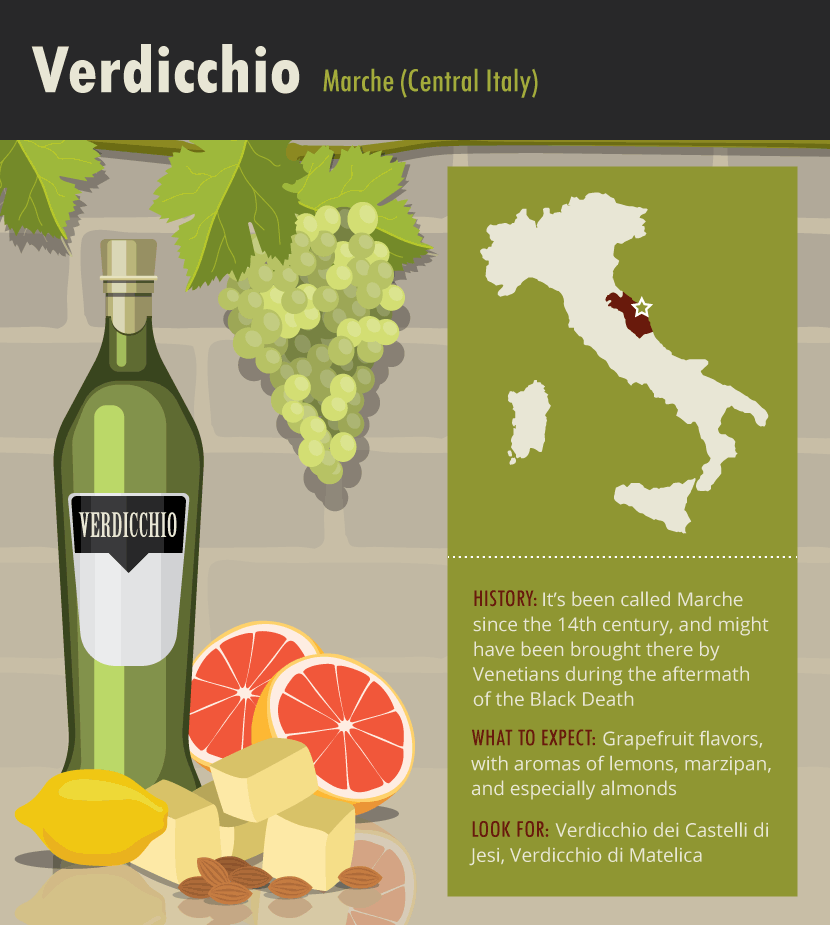
Fiano
In the early twentieth century, Fiano as a marketable wine was pretty much on life support. That Fiano found itself in that situation is astonishing,
considering that it is capable of making one of Italy’s best white wines, and considering that potential had been known for the previous eight hundred years!
Fiano might have been cultivated in ancient Roman times, and is believed to be one of the grapes in Pliny the Elder's viti apiane. Luckily for us, Fiano is cool again.
Fiano is native to southwest region of Campania, and probably originated in the Lapio area, where some of the best Fiano is still grown. You can get a sense of how beguiling
Fiano can be by picking up a wine designated Fiano di Avellino, or Sannio Fiano. Expect pineapple and tropical fruit flavors, with exotic aromas of spices, honey, and nuts; also
expect to feel like a true connoisseur as you spend way too much time sniffing those fantastic aromas.
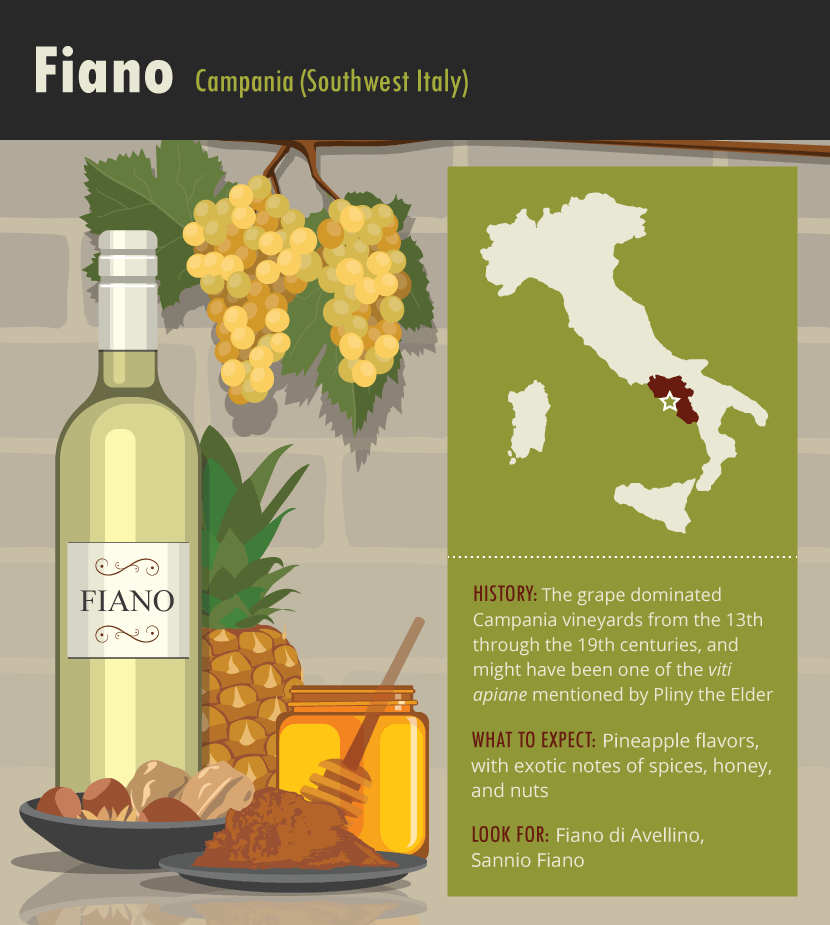
Carricante
As a grape, Carricante spent the last thousand years adapting to a very specific environment. It basically lives in only one place: the craggy,
otherwordly hillsides of the Mt. Etna volcano, where it thrives (making up about ninety-five percent of the white grape plantings in the region).
In fact, it thrives a bit too much, from a fine wine perspective; its name refers to “loading up” the donkey carts with large amounts of grapes, which
is the opposite of what you really want to do when making fine wine. When brought under control, however, Carricante can be exceptional.
In order to tame its high acidity, Carricante is often blended with other local white grapes, and in some cases barrel aged to help it soften on the palate.
Try Etna Bianco, and Etna Bianco Superiore, and expect lots of citrus and acidic “pop.” There will be notes of aniseed, flowers, mint, and – after aging – aromas of saline.
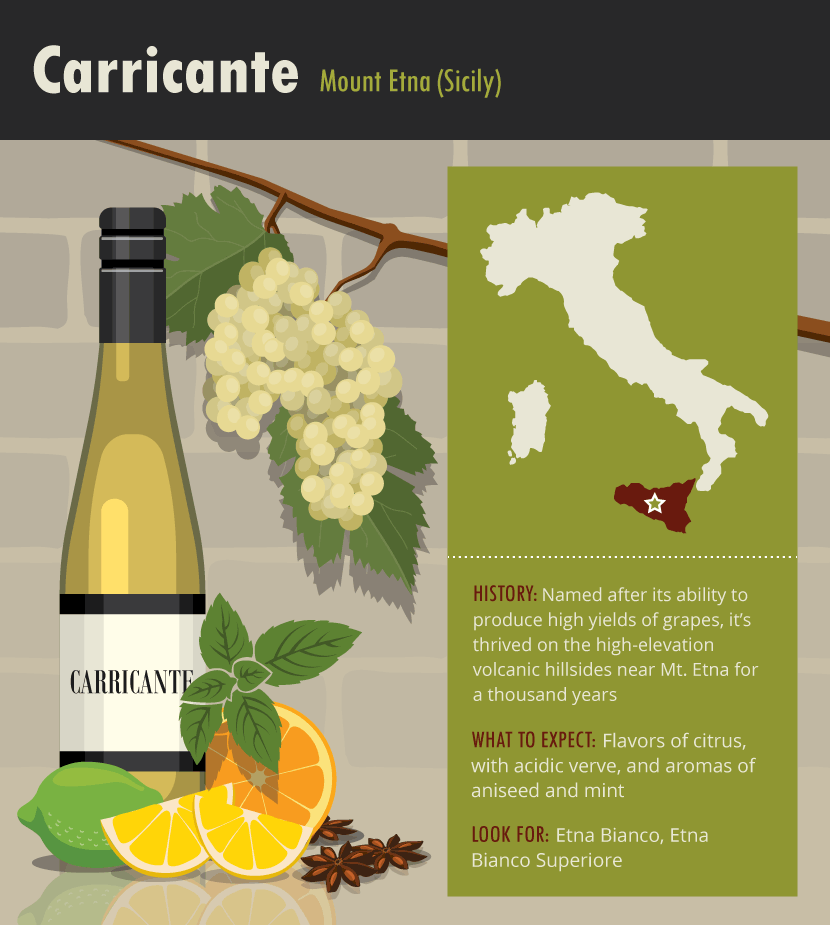
Zibibbo
Zibibbo (also known as Muscat of Alexandria), is just as much fun to drink as it is to say. While there is some debate as to its origins (it is commonly thought to
have originated in Africa), its Italian name is derived from the Arabic for raisin, and predates its other synonyms by about 150 years. It is one of the most primordial
wine grape varieties still used to make fine wine, has been widely planted worldwide, and is the parent of at least fourteen other important varieties.
Zibibbo makes high-quality dry and sweet wines on the wind-swept island of Pantelleria, off the coast of Sicily (though it’s technically closer to Tunisia than it is to Italy).
There, the Moscato di Pantelleria designation is used for dry wines that are vibrant and floral, and almost certain to get you smiling. Passito di Pantelleria describes a very special
treat: sweet wines made from dried Zibibbo grapes. These delicacies are rich and honeyed, with notes of spices, caramel, white flowers, and orange peel. They are a great option
for dessert on their own.
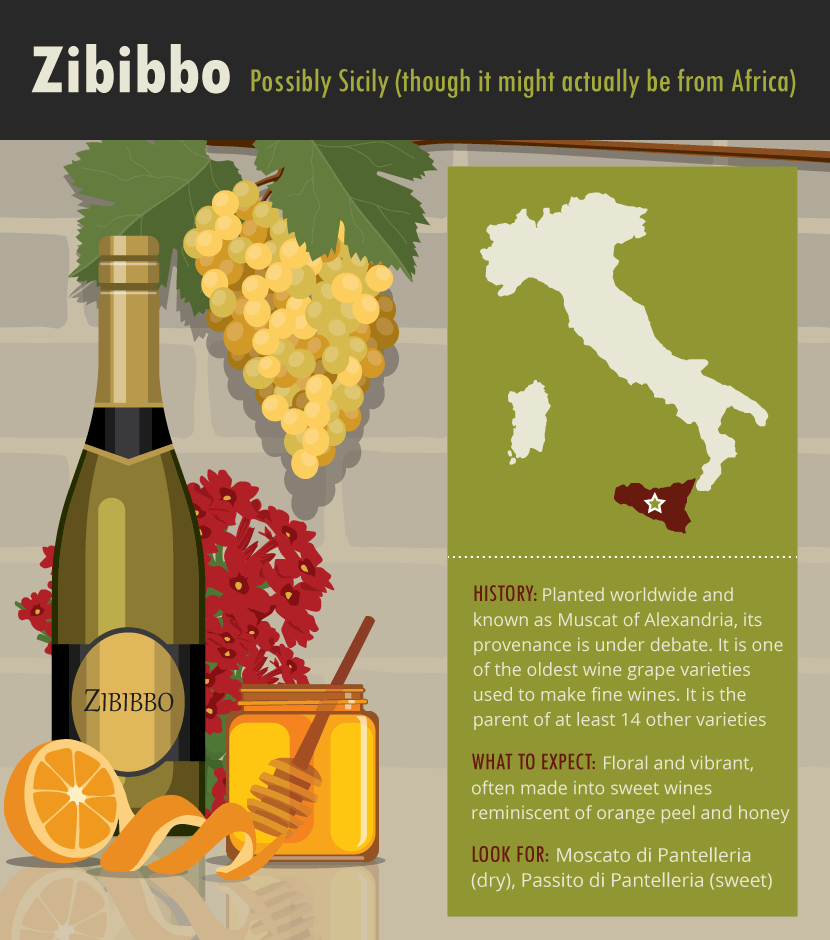 Whether you're daydreaming about a trip to Italia, or enjoying a plate of fettucine Alfredo, these Italian white wines are sure to make you say delizioso!
Whether you're daydreaming about a trip to Italia, or enjoying a plate of fettucine Alfredo, these Italian white wines are sure to make you say delizioso!
Embed the article on your site

